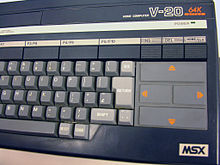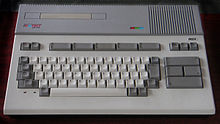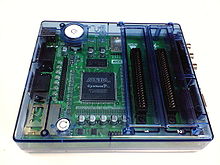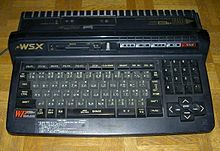- MSX
-
This article is about the home computer family. For other uses, see MSX (disambiguation) and MSX2 (disambiguation).
MSX 
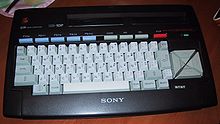
Sony MSX, Model HitBit-10-PRelease date 1983 (MSX) Discontinued 1995 (MSXturboR) Operating system MSX-DOS / MSX BASIC CPU Zilog Z80 Memory 16-512 KB MSX was the name of a standardized home computer architecture in the 1980s conceived by Kazuhiko Nishi, then Vice-president at Microsoft Japan and Director at ASCII Corporation. It is said that Microsoft led the project as an attempt to create unified standards among hardware makers.[1]
Despite Microsoft's involvement, the MSX-based machines were seldom seen in the United States and Britain [2] (although heavily advertised by Toshiba in the UK),[3] but they were popular in other markets. It is difficult to estimate how many MSX computers were sold worldwide, but eventually 5 million MSX-based units were sold in Japan alone, many of which were the later models.[4] This home computer was released in Japan, Middle East, Europe and Brazil.
Before the appearance and great success of Nintendo's Family Computer, MSX was the platform for which major Japanese game studios, such as Konami and Hudson Soft, produced their titles. The Metal Gear series was originally written for MSX hardware.[5]
Contents
History
In the 1980s, Japan was in the midst of an economic awakening.[6] Large Japanese electronics firms might have been successful in the early computer market had they made a concerted effort in the late 1970s. Their combined design and manufacturing power could have allowed them to produce competitive machines, but they initially ignored the home computer market and appear to have been hesitant to do business in a market where no industry standard existed.[7]
Nishi proposed MSX as an attempt to create a single industry standard for home computers. Inspired by the success of VHS as a standard for video cassette recorders, many Japanese electronic manufacturers along with GoldStar, Philips and Spectravideo built and promoted MSX computers. Any piece of hardware or software with the MSX logo on it was compatible with MSX products of other manufacturers. In particular, the expansion cartridge form and function were part of the standard; any MSX expansion or game cartridge would work in any MSX computer.
Nishi's standard consisted primarily of several off-the-shelf parts; the main CPU was a 3.58 MHz Zilog Z80,[8] the graphics chip a Texas Instruments TMS9918 with 16 KB of dedicated VRAM, the sound and partial I/O support was provided by the AY-3-8910 chip manufactured by General Instrument (GI), and an Intel 8255 Programmable Peripheral Interface chip was used for the parallel I/O such as the keyboard. This was a choice of components that was shared by many other home computers and games consoles of the period, such as the ColecoVision home computer (an emulator was later available with which MSX systems could run some of its software), and the Sega SG-1000 video game system. To reduce overall system cost, many MSX models used a custom IC known as "MSX-Engine", which integrated glue logic, 8255 PPI, YM2149 compatible soundchip and more, sometimes even the Z80 CPU. However, almost all MSX systems used a professional keyboard instead of a chiclet keyboard, driving the price up again. Consequently, these components alongside Microsoft's MSX BASIC made the MSX a competitive, though somewhat expensive, home computer package.
Debut
Yamaha YIS503II MSX Personal Computer
On 27 June 1983, the date considered the birthday of the MSX standard,[9] the MSX was formally announced during a press-conference, and a slew of big Japanese firms declared their plans to introduce machines. The Japanese companies avoided the intensely competitive U.S. home computer market, which was in the throes of a Commodore-led price war. Only Spectravideo and Yamaha briefly marketed MSX machines in the U.S. Spectravideo's MSX enjoyed very little success, and Yamaha's CX5M model, built to interface with various types of MIDI equipment, was billed more as a digital music tool than a standard personal computer.
Adoption
During the 1980s, Europe became the largest computer games (as opposed to console games) market in the world, and the extremely popular Commodore 64, Atari 8-bit, and Sinclair ZX Spectrum computers dominated. By the time the MSX launched in Europe several more popular 8-bit home computers had also arrived, and it was far too late to capture the extremely crowded European 8-bit computer market.[citation needed]
A problem for some game software developers was that the method by which MSX-1 computers addressed their video RAM could be quite slow compared to systems that gave direct access to the video memory. This, and the fact that the completely different features the MSX-1's video chip (using the MSX Video access method) had to compensate for the slower video access were not efficiently used while porting (mostly Spectrum) software, made the MSX-1 to appear slower when running ported games.[10][11]
Some minor compatibility issues also plagued ported Spectrum games. For example, the Toshiba HX-10 machine was unable to read certain key combinations at the same time, preventing the Spectrum "standard" of "Q, A, O, P steering", whereas machines by other manufacturers worked fine. Later (ported) games tended to use the MSX-1 joystick port or used MSX's official arrow keys and space bar, or offered the option to choose other keys with which to control the program, solving the problem.[citation needed]
A larger problem was that the designers of the MSX standard bank switching protocol did not prescribe to hardware manufacturers in which banks the cartridges, but more important the RAM, should be found. Moreover, the MSX's BIOS did not provide this information either, thus requiring programmers to implement complex routines to "find" these resources. Often programmers assumed that the RAM and cartridges would be available at a "default" bank switch location; in reality some systems had their RAM or cartridge slot(s) not at the "default" location, but on another bank switch location. In those cases programs failed to run because they only "saw" 32 KB of the available memory, instead of the full 64 KB that almost all MSX-1 machines offered. With very few exceptions, except for a very early Phillips MSX-1 model, (the VG8000) and the SVI-318 almost all other mainstream MSX-1 machines offered at least the full 64 KB of RAM.
Evolution
MSX spawned four generations: MSX (1983); MSX2 (1986); MSX2+ (1988); and MSX TurboR (1990). The first three were 8-bit computers based on the Z80 microprocessor, while the MSX TurboR was based on an enhanced Zilog Z800 known as the R800. The MSX TurboR was introduced in 1990 but was unsuccessful due to a lack of support and the rise in popularity of the by then well-established IBM PC Compatible market. Production of the TurboR ended in 1993 when Panasonic decided to focus on release of 3DO.[citation needed]
The MSX3 was scheduled for market in 1990. Delays in the development of its VDP—then named V9978 on the pre-release spec sheets—caused Yamaha to miss its time to market deadline.[12] In its place, an improved MSX2+ was released as the MSX Turbo-R; features of the new R800 processor such as DMA and 24-bit addressing were disabled. The VDP was eventually delivered two years after its planned deadline, by which time the market had moved on. In an attempt to reduce its financial loss, Yamaha stripped nearly all V9958 compatibility and marketed the resulting V9990 E-VDP III as a video-chipset for PC VGA graphic cards, with moderate success. Sony also employed the V7040 RGB encoder chip on many other products. MSX-FAN Magazine also mentions the then impressive power of the V9990, being able to compete with much more expensive hardware such as the Sharp X68000.
Impact
 A Sakhr (صخر), made in Kuwait and used in Egypt and the Arab states of the Persian Gulf. It is a copy of the Yamaha AX120
A Sakhr (صخر), made in Kuwait and used in Egypt and the Arab states of the Persian Gulf. It is a copy of the Yamaha AX120
MSX never became the worldwide standard that its makers had envisioned, mainly because it never took off in the U.S. and the UK. However, in Japan, South Korea, Argentina, and Brazil, MSX was the paramount home computer system in the 1980s. It was also quite popular in continental Europe, especially in the Netherlands and Spain. Classrooms full of networked Yamaha MSX were used for teaching informatics in school in some Arab countries and the Soviet Union.
In the 1980s, Sakhr (صخر) Computers (Developed by Al Alamyyeh, a Kuwaiti company), started the production of the first Arabic version of MSX computers. They started producing a Yamaha AX100, but also a few other models including MSX2 and MSX2+ models. The most popular and affordable model within CCASG was the Sakhr MSX AX170. They were also the first to Arabize BASIC and the MSX LOGO.[citation needed]
Many MSX computers were used during the 1980s in Eastern European (former Eastern Bloc) countries as a tool for subtitling pirated films on VHS, or Betamax cassettes. The MSX computers were used for their simplicity and its ability to display prepared titles in real time as superimpose text on mastering tapes.[citation needed]
In total, 5 million MSX computers were sold, which made it relatively popular but not the global standard it was intended to be. For a comparison with rival 8-bit computers, the Commodore 64 sold 17 million units worldwide in its lifetime, the Apple II sold 6 million units,[13] the Atari 8-bit sold at least 4 million units, the Amstrad CPC sold 3 million units, and the Tandy TRS-80 sold 250,000 units.[citation needed]
One (Sony) MSX2 machine was even launched into space on board of a Russian MIR spacecraft [14]
Name
The exact meaning of the "MSX" abbreviation remains a matter of debate. At the time, most people seemed to agree it meant 'MicroSoft eXtended', referring to the built-in "Microsoft eXtended BASIC" (MSX-BASIC), specifically adapted by Microsoft for the MSX system. Another suggested source for the abbreviation was Matsushita-Sony. However, according to Kazuhiko Nishi, MSX could also stand for "Machines with Software eXchangeability". Perhaps because of a general aversion to the global player Microsoft, this version was welcomed by the MSX community. In 1985, Kazuhiko Nishi told that he named MSX after the MX missile. The MSX-DOS disk operating system had file system compatibility with CP/M and was similar to MS-DOS. In this way, Microsoft could promote MSX for home use while promoting MS-DOS based personal computers in office environments.[citation needed]
Similar systems
The system MSX most closely resembled was the Spectravideo SV-328 home computer (Spectravideo even claimed to be "MSX compatible" in advertisements before the actual launch of MSX systems, but it was in fact not completely compatible with it). This led to a new and short-lived kind of software cracking: converting. Since the MSX games were unplayable on the SV-328 computer, SV-328 crackers developed a method of modifying the (MSX) games to make them work on the SV-328. In most cases this included downloading the MSX BIOS to the SV-328 from tape or floppy disk. Spectravideo later launched the SV-728 which completely adhered to the MSX standard.
2001 Revival
In 2001, Kazuhiko Nishi initiated a 'MSX Revival' around an official MSX emulator called MSXPLAYer. This is the only official MSX emulator as all MSX copyrights are maintained by the MSX Association. In 2004, a Dutch company Bazix announced they had become the representatives of MSX Association in Europe, being the English contact for any questions regarding the MSX trademarks and copyrights (licensing). On October 17, 2006, Bazix launched WOOMB.Net, a website selling MSX games (translated to English if necessary), with a selection of 14 games. In Japan, game sales began earlier, through Project EGG. WOOMB.Net was the English counterpart of this (and other) Japanese services offered by D4 Enterprise, which also announced (in August 2006) the launch of a new MSX2 compatible system called the "one chip-MSX", a system based on an Altera Cyclone EP1C12Q240C8 FPGA.[15] The one chip-MSX" is similar in concept to the C-One, a Commodore 64 clone also built on the basis of a single FPGA chip. The new MSX system is housed in a box made out of transparent blue plastic, and can be used with a standard monitor (or TV) and a PC keyboard. It has two MSX cartridge slots and supports the audio extensions MSX-MUSIC and SCC+. A SD/MMC-flashcard can be used as an external storage medium, emulating a disk drive and can be used to boot MSX-DOS. Due to its VHDL programmable hardware it is possible to give the device new hardware extensions simply by running a reconfiguration program under MSX-DOS. The "one chip-MSX" also has two USB connectors that can be used after adding some supporting VHDL code.
On June 7, 2008, the MSX Resource Center Foundation reported that the MSX trademark had moved from MSX Association to the MSX Licensing Corporation,[16] referring to a Benelux trademark register page of MSX, which names the MSX Licensing Corporation as entitled entity till 28-10-2013.[17] At that time, the website of the MSX Licensing Corporation that they linked to as source, had a text saying 'We are planning to revitalize MSX, the innovative computer platform.' on it. However, the website was later changed to contain only the logo of ITNY & Partners, and a link to ITNY & Partners' English and Japanese websites and has no mention of the MSX Licensing Corporation at all. O June 26, 2008, Bazix reported on their website's frontpage that they are no longer the representative of MSX Association, due to being unable to achieve their goals of "bringing about the commercial MSX Revival beyond the Japanese borders" and "the transfer of the MSX trademark from MSX Association to MSX Licensing Corporation" and "no outlook on any progress in the Western One Chip MSX project any time soon". As a result of this, WOOMB.Net is taken offline as well, with its website redirecting to the Bazix website, till "a solution free of MSX Association's contributions has been completed". According to their post, they will cooperate with D4 Enterprise and the MSX Licensing Corporation "in one or more retro gaming related projects".
On July 4, 2008, MSX Association's European contact website, which states to be the "only official contact place for MSX Association in Europe", reports that the MSX trademark and copyright has been under the MSX Licensing Corporation holding ever since 1983. It explains that MSX Association, chaired by Dr. Kazuhiko Nishi is the operational division of MSX Licensing Corporation which manages the trademarks, logo and copyrights for MSX. According to the same article, D4 Enterprise "refuse to pay royalties to MSX Association for the use of ESE Artists' Factory's work in 1chipMSX and the software licenses in Project Egg", thus they deal with Kazuhiko Nishi 'directly' through the MSX Licensing Corporation. The article mentions as well the ESE MSX System 3, on which the 1chipMSX (also known as One Chip MSX or OCM) is based.
On July 5, 2008, the MSX Association's Europe website posted an announcement reporting that D4 Enterprise was selling the 1chipMSX illegally.[18] In the same post it is stated that Bazix no longer is their representative in Europe, due to Bazix cutting off their relationship.
Nintendo virtual console
Nintendo of Japan posted on its Virtual Console webpage that MSX games will be available for Wii's Virtual Console emulator. In February 2007, it was confirmed again and announced that the games would cost 700 Wii Points and will become available in the middle of 2007 (for Japan only, at least initially).
Franchises established on the MSX
The most popular and famous MSX games were written by Japanese software-houses such as Konami and Hudson Soft. Several popular video game franchises were initially established on the MSX:
- Aleste and Zanac (the latter developed and released alongside the original FDS version)
- Bomberman
- Penguin Adventure
- Eggerland
- Metal Gear
- Parodius
- Puyo Puyo
Others got various installments on the MSX, including some titles unique to the system or largely reworked versions of games on other formats:
- Castlevania (as Vampire Killer)
- Contra
- Dragon Quest
- Dragon Slayer
- Final Fantasy
- Gradius (Nemesis)
- R-Type
- Wizardry
- Xak
- Ys
Manufacturers
Main article: List of MSX compatible computers- MSX
- Spectravideo, Philips, Al Alamia, Sony, Sanyo, Mitsubishi, Toshiba, Hitachi, National, Panasonic, Canon, Casio, Pioneer, Fujitsu General, Yamaha, JVC, Yashica-Kyocera, GoldStar, Samsung/Fenner, Daewoo/Yeno, Gradiente, Sharp/Epcom, Talent.
- MSX2
- Philips, Sony, Sanyo, Samsung, Mitsubishi, Victor (a.k.a. JVC), National, Panasonic, Canon, Yamaha, ACVS, DDX, Daewoo/Yeno, NTT, Talent.
- MSX2+
- Sony, Sanyo, Panasonic, ACVS, DDX.
- MSX TurboR
- Panasonic.
System specifications
MSX
 The effect of attribute clash when using the 256×192 Highres mode of MSX 1.
The effect of attribute clash when using the 256×192 Highres mode of MSX 1.
- Processor: Zilog Z80A running at 3.58 MHz
- ROM: 32 KB
- RAM: 8 KB minimum, most machines provided either 32 or 64 KB; machines with 128 KB exist
- Video Display Processor: Texas Instruments TMS9918 family
- Video RAM: 16 KB
- Text modes: 40×24 and 32×24
- Resolution: 256×192 (16 colours). In reality there are just 15 colour tints available, because, just like Sinclair Spectrum there are two versions of black. Unlike the Spectrum however, one of the blacks is actually "transparent", so the MSX video picture could be overlayed on another video signal, for example one from a video disk.
- Sprites: 32, 1 colour, max 4 per horizontal line
- Sound chip: General Instrument AY-3-8910 (PSG)
MSX2
- Processor: Zilog Z80A running at 3.58 MHz
- ROM: 48 KB
- BIOS + Extended BIOS (32 KB)
- MSX BASIC V2.0 or V2.1 (16 KB)
- DiskROM (16 KB) (optional, common)
- MSX-Audio BIOS (32 KB) (optional, no machines are known with this BIOS built in)
- RAM: 64 KB minimum, commonly 128 KB in Europe, 64 KB on Japanese computers, machines with up to 512 KB were made
- Memory mapped (4 MB/slot max) (optional)
- Video Display Processor: Yamaha V9938 (a.k.a. MSX-Video) Supports all MSX video modes plus:
- Increased video RAM: 128 KB (sometimes 64 or 192 KB)
- New text mode: 80×24
- New bitmaped video modes without the attribute clash of MSX 1
- New resolutions: 512×212 (16 colours out of 512) and 256×212 (256 colours)
- Increased number of, and more advanced sprites: 32, 16 colours, max 8 per horizontal line
- Hardware acceleration for copy, line, fill, etc.
- Interlacing to double vertical resolution
- A vertical scroll register
- Vertical and horizontal display offset register
- Sound chip: Yamaha YM2149 (PSG)
- Clock chip: Ricoh RP5C01 (or compatible)
- 3.5 in (89 mm) Floppy disk drive is common
MSX2+
- Only officially released in Japan (available in Europe and Brazil via upgrades)
- Processor: Zilog Z80 compatible running at 3.58 MHz or more (5.37 MHz and 7.16MHz versions were available)
- ROM: 64 KB
- BIOS + Extended BIOS (32 KB)
- MSX BASIC V3.0 (16 KB)
- DiskROM (16 KB) (optional, very common)
- Kun-BASIC (16 KB) (optional)
- Kanji ROM (optional)
- RAM: commonly 64 KB (on Japanese computers)
- Memory mapped (4 MB/slot max)
- Video Display Processor: Yamaha V9958 (aka MSX-Video) All of MSX2's specifications plus:
- The minimal video RAM is now 128 KB. Up to 192KB is supported.
- a new 256×212 YJK video mode with 19268 simultaneous colors
- a new 256×212 mixed-YJK/RGB video mode with 12499 simultaneous colors
- a horizontal scroll register
- Sound chip: Yamaha YM2149 (PSG)
- Optional sound chip: Yamaha YM2413 (OPLL) (MSX-Music)
- Clock chip RP5C01
- 3.5 in (89 mm) Floppy disk drive is very common
MSX TurboR
- Only released in Japan
- Processor: R800 and Zilog Z80A compatible
- R800 running at 7.16 MHz (instructions use about 4x less clock ticks than the Z80, so often quoted as 28.6 MHz when comparing with the Z80)
- Zilog Z80A compatible (embedded in the T9769C MSX-Engine) running at 3.58 MHz for backward compatibility
- ROM: 96 KB
- BIOS + Extended BIOS (48 KB)
- MSX BASIC V4.0 (16 KB)
- DiskROM (16 KB)
- Kun-BASIC (16 KB)
- Kanji ROM (256 KB)
- Firmware (4 MB)
- RAM: 256 KB (FS-A1ST) or 512 KB (FS-A1GT)
- Memory mapped (4 MB/slot max)
- Additionally 16 KB (FS-A1ST) or 32 KB (FS-A1GT) of SRAM (battery-powered)
- Video Display Processor: Yamaha V9958 (aka MSX-Video) so the same capabilities as MSX2+
- Sound chip: Yamaha YM2149 (PSG)
- Sound chip: Yamaha YM2413 (OPLL) (MSX-Music)
- Sound chip: PCM
- 8-bit single channel (no DMA), 16 kHz max using BIOS routines.
- Microphone built-in
- Sound chip: MIDI in/out (FS-A1GT only)
- Clock chip
- 3.5 in (89 mm) Floppy disk drive
Peripherals
Floppy disk drives
MSX systems generally did not have a built-in disk drive, so games were published mainly on cartridge and cassette tape.[7] Sony created a battery backed RAM cartridge the HBI-55 "data cartridge" for a few computers of their "Hit-Bit" line of MSX systems, that could be used to store programs or data as an alternative to cassette tapes. [19]
Floppy disk drives were available for MSX however, in the form of a cartridge containing the disk interface electronics and a BIOS extension ROM (the floppy disk drive interface), connected to an external case with the drive. In South-America, many of these systems used a 5.25 in (133 mm) floppy disk drive, but in Europe, mostly the 3.5 in (89 mm) drives were popular. In Japan, some MSX1 systems included a built-in 3.5" disk drive, like Panasonic (earlier named Matsushita) CF-3000. In Europe, a whole range of Philips MSX2 systems NMS 8230, 8235, 8245, 8250 and up features either 360 or 720 Kb 3.5" floppy drives.
In 1985, the MSX2 was released, which systems often (but not always) included a built-in 3.5" disk drive too, and consequently the popular media for games and other software shifted to floppy disks.
The MSX 3.5" floppy disks are directly compatible with MS-DOS (although some details like file undeletion and boot sector code were different). Like MS-DOS 1, MSX disks (formatted) under MSX-DOS 1 have no support for subdirectories.[20]
MSX-Audio
- Yamaha Y8950, also known as:
- Panasonic: MSX-Audio (standard name)
- Philips: Music Module (no MSX-Audio BIOS)
- Toshiba: MSX FM-synthesizer Unit (no sample RAM, no MSX-Audio BIOS)
- 9 channels FM or 6 channels FM + 5 drums
- ADPCM record and play, with Hardware acceleration
- 32 KB of sample RAM, which can be upgraded to 256 KB
MSX-Music
- Yamaha YM2413 (OPLL), also known as:
- MSX-Music (standard name)
- Panasonic: FM-PAC
- Zemina: Music Box
- Checkmark: FM-Stereo-Pak
- 9 channels FM or 6 channels FM + 5 drums
- 15 pre-set instruments, 1 custom
- Built-in as new standard on MSX2+ and MSX TurboR computers
Emulation
Main article: List of MSX emulatorsMSX computers are emulated on many platforms today. Most MSX emulators are (or were) based on the code of the pioneer fMSX, a portable MSX emulator by Marat Fayzullin. fMSX source code license is not free and many emulators removed Fayzullin's Z80 emulation code entirely in later versions to avoid legal problems.
The official MSX emulator MSXPLAYer (Japanese) is produced by the MSX Association, of which MSX standard inventor Kazuhiko Nishi is the president.
Some MSX titles are emulated in the Nintendo Wii's Japanese Virtual Console.
See also
- History of computing hardware
- List of MSX compatible computers
- List of MSX games
- Moonsound
- SymbOS
- Zemmix
- Canon T90
References
- ^ http://www.enotes.com/topic/Kazuhiko_Nishi
- ^ http://www.atarimagazines.com/creative/v10n8/198_Faceoff_will_MSX_be_a_su.php
- ^ http://www.old-computers.com/museum/computer.asp?c=438
- ^ http://msx.gnu-linux.net/statistics.html
- ^ "Kojima Productions". Konami.jp. http://www.konami.jp/kojima_pro/english/history.html. Retrieved 2011-06-22.
- ^ "Maciamo (2004-05-16). Japan's postwar economic miracle (1950-1990). Japan Reference, 16 May 2004". Jref.com. 2004-05-16. http://www.jref.com/society/japan_postwar_economic_miracle.shtml. Retrieved 2011-06-22.
- ^ a b "Dvorak, John C. (2006-11-28). Whatever Happened to MSX Computers?. Dvorak Uncensored, 28 November 2006". Dvorak.org. 2006-11-28. http://www.dvorak.org/blog/whatever-happened-to-msx-computers. Retrieved 2011-06-22.
- ^ Dvorak, John C. (7–14 January 1985). "MSX: The pong of the 1980s". InfoWorld (InfoWorld Media Group) (Vol. 7, Num. 1-2): 88. ISSN 0199-6649.
- ^ http://retrovideogamesystems.com/the-toshiba-hx-10-64k-msx/
- ^ http://map.grauw.nl/articles/vdp_tut.php
- ^ http://www.infinitemsx.com/index.php?option=com_content&view=article&id=21:screen2-output&catid=16:blog&Itemid=7
- ^ MSX-FAN Magazine (1995 February issue, p. 90)
- ^ "Mac Daily News 5 to 6 million Apple IIs sold". Macdailynews.com. http://www.macdailynews.com/index.php/weblog/comments/happy_30th_birthday_apple_ii/. Retrieved 2011-06-22.
- ^ http://msx.gnu-linux.net/msx-in-space/
- ^ MSX Resource Center. "One Chip MSX MKII". Msx.org date=. http://www.msx.org/One-Chip-MSX-MKII.newspost3805.html. Retrieved 2011-06-22.
- ^ MSX Resource Center. "MSX Resource Center Foundation about MSX trademark". Msx.org. http://www.msx.org/MSX-revival-update%3A-Wii%2C-Trademarks%2C-1chipMSXes-and-more.newspost4762.html. Retrieved 2011-06-22.
- ^ "Benelux trademark registration for the MSX trademark" (in (Dutch)). Register.boip.int. http://register.boip.int/bmbonline/details/trademark/show.do?markID=37573&markNumber=396134&markNumberType=REG. Retrieved 2011-06-22.
- ^ http://eur.msxa.org/en/node/6
- ^ picture of HBI-55 data cartridge
- ^ "MSX-DOS 2 section". The Ultimate MSX FAQ. Faq.msxnet.org. http://www.faq.msxnet.org/dos2.html. Retrieved 2011-06-22.
External links
- MSX at the Open Directory Project
Categories:- MSX
- Home computers
- Retrocomputing
Wikimedia Foundation. 2010.

